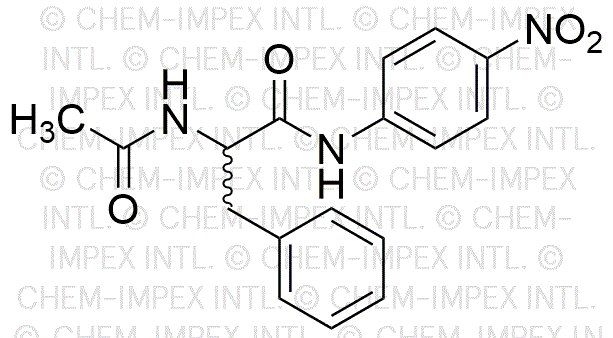Acetyl-DL-phenylalanine 4-nitroanilide is widely utilized in research focused on:
- Biochemical Assays: This compound serves as a substrate in enzyme assays, particularly in studying proteases and peptidases, helping researchers understand enzyme kinetics and mechanisms.
- Drug Development: It is used in pharmaceutical research to evaluate the efficacy of new drug candidates, particularly those targeting neurological disorders, due to its structural similarities to amino acids.
- Analytical Chemistry: This chemical acts as a reagent in various analytical techniques, including chromatography and spectrophotometry, facilitating the detection and quantification of other compounds.
- Protein Synthesis Studies: Researchers utilize it to investigate protein synthesis and folding, contributing to the development of biotechnological applications in protein engineering.
- Educational Purposes: It is often employed in academic laboratories for teaching purposes, allowing students to explore chemical reactions and molecular interactions in a hands-on environment.
Informations générales
Propriétés
Sécurité et réglementation
Applications
Acetyl-DL-phenylalanine 4-nitroanilide is widely utilized in research focused on:
- Biochemical Assays: This compound serves as a substrate in enzyme assays, particularly in studying proteases and peptidases, helping researchers understand enzyme kinetics and mechanisms.
- Drug Development: It is used in pharmaceutical research to evaluate the efficacy of new drug candidates, particularly those targeting neurological disorders, due to its structural similarities to amino acids.
- Analytical Chemistry: This chemical acts as a reagent in various analytical techniques, including chromatography and spectrophotometry, facilitating the detection and quantification of other compounds.
- Protein Synthesis Studies: Researchers utilize it to investigate protein synthesis and folding, contributing to the development of biotechnological applications in protein engineering.
- Educational Purposes: It is often employed in academic laboratories for teaching purposes, allowing students to explore chemical reactions and molecular interactions in a hands-on environment.
Documents
Fiches de données de sécurité (FDS)
La FDS fournit des informations de sécurité complètes sur la manipulation, le stockage et l’élimination du produit.
Spécifications du produit (PS)
Le PS fournit une description complète des propriétés du produit, notamment sa composition chimique, son état physique, sa pureté et les exigences de stockage. Il détaille également les plages de qualité acceptables et les applications prévues du produit.
Certificats d'analyse (COA)
Recherchez des certificats d'analyse (COA) en saisissant le numéro de lot du produit. Les numéros de lot et de lot se trouvent sur l'étiquette d'un produit, après les mots « Lot » ou « Lot de fabrication ».
Numéro de catalogue
Numéro de lot/série
Certificats d'origine (COO)
Ce certificat d'exploitation confirme le pays dans lequel le produit a été fabriqué, et détaille également les matériaux et composants utilisés et s'il est issu de sources naturelles, synthétiques ou autres sources spécifiques. Ce certificat peut être requis pour les douanes, le commerce et la conformité réglementaire.
Numéro de catalogue
Numéro de lot/série
Fiches de données de sécurité (FDS)
La FDS fournit des informations de sécurité complètes sur la manipulation, le stockage et l’élimination du produit.
DownloadSpécifications du produit (PS)
Le PS fournit une description complète des propriétés du produit, notamment sa composition chimique, son état physique, sa pureté et les exigences de stockage. Il détaille également les plages de qualité acceptables et les applications prévues du produit.
DownloadCertificats d'analyse (COA)
Recherchez des certificats d'analyse (COA) en saisissant le numéro de lot du produit. Les numéros de lot et de lot se trouvent sur l'étiquette d'un produit, après les mots « Lot » ou « Lot de fabrication ».
Numéro de catalogue
Numéro de lot/série
Certificats d'origine (COO)
Ce certificat d'exploitation confirme le pays dans lequel le produit a été fabriqué, et détaille également les matériaux et composants utilisés et s'il est issu de sources naturelles, synthétiques ou autres sources spécifiques. Ce certificat peut être requis pour les douanes, le commerce et la conformité réglementaire.


